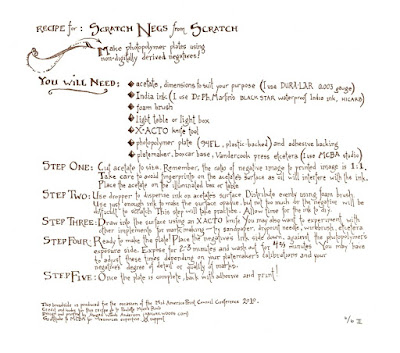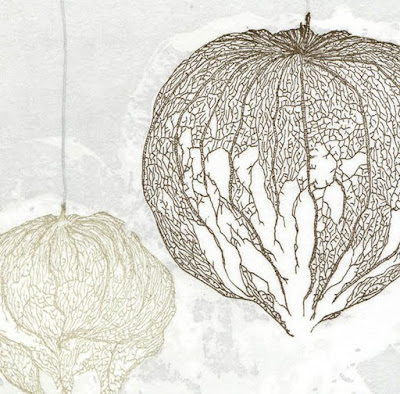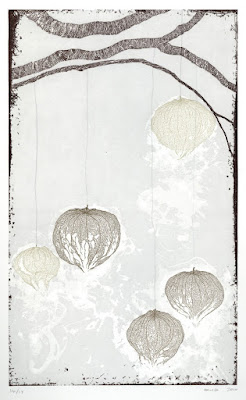It is not often that I come across a new technique and a fresh point of view in printmaking. If anywhere, the SGC and MAPC conferences are great events to attend if have been lacking inspiration lately. Abigail Anderson's artwork caught my eye at the last MAPC Conference and I just had to share it with you. It's been an interview long promised, so I hope you will be as inspired as I was when I met her.
Abigail Woods Anderson is a Minneapolis- based artist and educator. She received her BA from St Olaf College in 1999 and currently works with the Walker Art Center's department of education and community programs. Abigail is also an instructor and member of the artist cooperative at Minnesota Center for Book Arts (MCBA) and made her curatorial debut there at the Lerner Binder Gallery this spring (a multidisciplinary exhibition What Follows What Came Before).
I was drawn to her work because of the detail that she was able to get with photopolymerplates and her hand drawn negatives. Here is what Abigail had to say about her technique: "What's striking about letterpress is that it is at once anachronistic and in vogue. Artists working in letterpress have a vast array of technologies (two millenia) at their disposal. What sets my technique apart from most contemporary letterpress practitioners is my preference for handmade, rather than digitally derived, negatievs to generate photopolymer plates. I thrive off the direct mark-making and problem solving ingenuity of DIY processes and analog materials. Occasinally, specific projects necessitate the facsimile quality that a computer affords, but usually my process is more akin to drawing and painting."
Degrees, detail

Abigail was great in sharing how she makes her negatives. Her basic technique is to paint a solid surface of India Ink with a foam brish on acetate and let it dry. Then you can use the scratching tool of your choice (x-acto knife, etching needle, sandpaper, wire brush, etc.) After you make the drawing you can expose your plate the way you normally would. I'd suggest making a couple of trial plates to get the exposure right.

Now, here is an image of one of Abigails negatives. You can see how much detail and fine lines she has. That is what was so mind blowing to me. I asked her what the trick is to keep the fine lines from washing away after exposure. Her reply was to keep the highly detailed areas close together, and then have the rest of the area open. If there was one little mark in the middle of a large open area, then it would wash away, but having the lines so close together keeps them "safe".
I asked Abigail to share some more of herself and her work with us:
How/when did you start letterpress?
I confess- I had no idea what letterpress meant when I signed up for a workshop at the MCBA in 2008. My first instructor was Allison Chapman and my first projects were entirely engrossing and overly ambitious. So I was compelled to continue coursework at MCBA by taking classes in advanced letterpress and polymer plate making. I knew I had the letterpress obsession once I noticed myself laying awake at night concocting letterpress projects. So, to satiate this creative impulse, I joined MCBA's Artist Cooperative which consists of artists making independently driven work in the book arts disciplines- papermaking, printmaking and book binding. In exchange for monthly dues, we get a host of benefits, not least which is access to MCBA's studio space and equipment.
 Re-Embroidered II, letterpress, 7"x7", print above, detail below
Re-Embroidered II, letterpress, 7"x7", print above, detail below
For someone who has not seen your work, how would you explain it?
I think my artwork has a certain "telescoping inward" quality. While subjects vary, my prints and paintings consistently are small scale and highly detailed. The notion of making visual riddles- compositions held together by some kind of tension or enigma- has held my attention recently.
Strange Loop is a good example. I developed a resource about this painting that is a hybrid of an artist statement and statement of influence. Artist voice/Artist Choice was a project proposed and supported by my colleagues at the Walker, mnartists.org and the Minneapolis Institute of Arts. It invites artists to discuss their own work in relation to resources held by the Walker and/or Minneapolis Institute of Arts.
Shelf Fungus, letterpress & chine colle, 4"x2.5"

Do you work in any other media than polymerplates?
While I only discovered letterpress about three years ago, I discovered love for printmaking about 12 years ago in a college intaglio class. But graduating college meant saying farewell to a sophisticated studio. I scaled back to art forms that could be accomplished in a small apartment. For several years I worked in pencil, pen and ink, watercolor, and gouache. Now that I am invested in printmaking, those direct media still interest me but are on the back burner. Within the medium of letterpress, I use primarily polymer plate, but occasionally employ metal type.
Where do you get your inspiration from for themes and colors? Do you always work with nature themes?
I often work with nature themes, but over the years my approach has edged a bit more towards abstraction. Recently I completed two works relating to mathematical principles. {2, 3, 5, 7, ... 2203, 2207} and {2, 3, 5, 7, ... 1789, 1801} are meditations on the prime number sequence. These prints reference the work of mathematicians Stanislaw Ulam and Charles Sacks.
 Nulla Dies Sine Linea, letterpress, detail above and print below
Nulla Dies Sine Linea, letterpress, detail above and print below
Any great plans for the future?
To be fair, this is less of a plan and more of an ambition, but I'd like to edition an artist book about water bears. Also (totally unrelated) this summer I've got what I'm calling my "Gutenberg gig". On Spetember 24-25 I will be demonstrating the use of a Gutenberg replica press at the Minnesota Renaissance Festival.
Other exciting things? This summer I have an experimental outdoors project called Open Phenology (science of how and when living things change over the seasons). I engage the public every friday in a meandering walk and conversation during which we identify species, hypothesize about our observations and share knowledge. Then I use a blog to keep records of our phenological observations (with a good dose of musings and non-authoritative content). Open Phenology is my contribution to the Walker Art Center's Open Field and Field Office. It's part of my bigger fascination with citizen science and the perils and powers of inviting non-scientists to be collaborators in scientific pursuits.
I fell in love with your prints, do you have any for sale?
My art is available at the Groveland Gallery in Minneapolis.
 Minuend, letterpress, 8.5"x5", detail above and print below
Minuend, letterpress, 8.5"x5", detail above and print below
Thanks so much for sharing Abigail!
